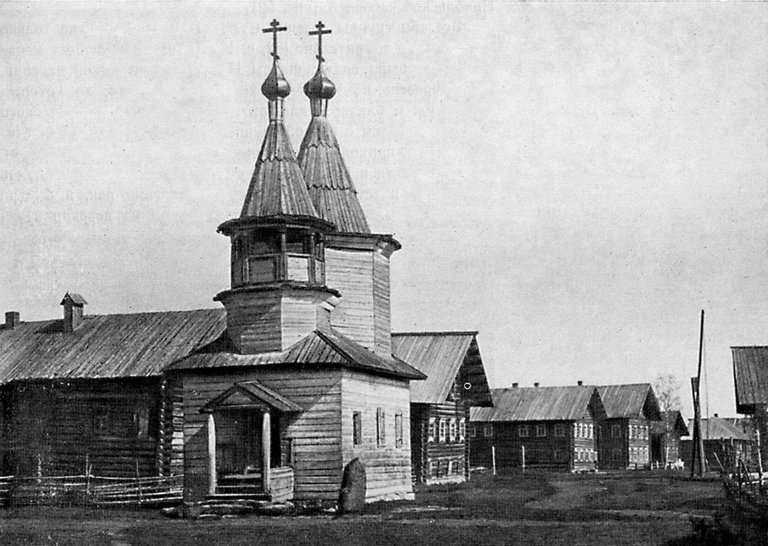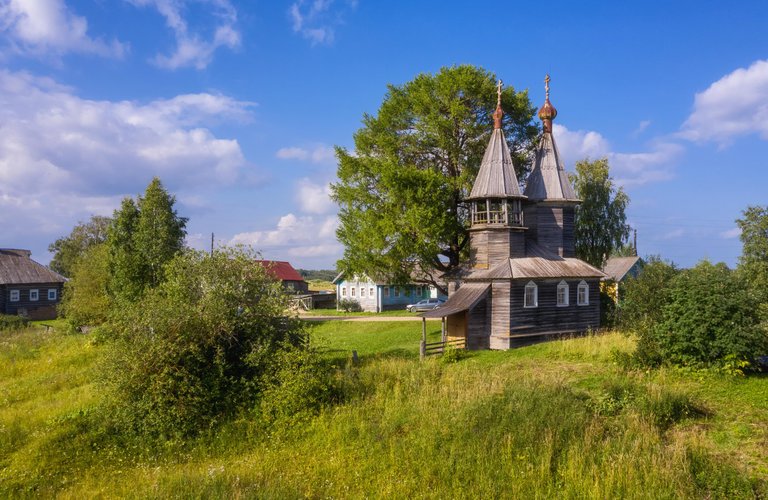Russian wooden architecture is the direction of traditional architecture in Russia, with its pronounced features, determined by the main building material - wood. This is how our ancestors built many centuries ago, improving the technique of processing wood and building. Wood is not the most durable material, therefore, every year, monuments of wooden architecture, especially in the absence of proper maintenance and repair, are lost at an alarming rate: they burn, rot, collapse, they are dismantled for firewood ... The age of a building of one and a half to two hundred years is considered already very large, because a wooden building will not last a thousand years or more, unlike a stone one. But with stone buildings there was a great difficulty: in the primordial Russian, mainly northern territories, there was very little stone and rocks for use as building material, and the production of bricks was very expensive, so they were used only in single, largest and most monumental buildings. But wood was used everywhere.
The most beautiful and reliable of all the buildings that were built in the old days are, of course, churches. Up to the twentieth century, a huge number of simple wooden houses (huts) were built, but people also made them simpler in appearance, and decorated them less. Of course, there were also wooden towers and boyar mansions, but they have survived in small numbers.
But the construction of a church or a chapel was a real reason to show the maximum of creative thought and building skill of the people, so the builders tried much more, they did everything carefully, for centuries. If we talk about large temples and cathedrals, then they were often built of stone, but smaller churches and chapels were still mostly wooden. Therefore, when we talk about Russian wooden architecture, churches are most often cited as the most striking examples, peaks of development and monuments of this architectural style.
This year and last year, I traveled a little across Russia in search of these still living examples of the construction skills of our ancestors. I wanted to finally see them with my own eyes and take pictures, and besides, with international travel, as everyone understands perfectly well, it was quite difficult that year (and still remains). Therefore, very soon I will from time to time show you photographs of Russian Orthodox churches, almost all of them are wooden, many are historical and architectural monuments. Wooden architecture of the Russian North - I hope you will be interested :)
I am not a specialist in architecture or even history of that period, but I really like to look at such buildings. I apologize in advance if specific architectural terms are conveyed by me in English not quite correctly — it is a little difficult, and if someone can correct me, it will be great.
In the photos of today's post — the Chapel of Elijah the Prophet in the village of Big Khaluy, Arkhangelsk region (Khaluy — from the name of the river flowing nearby). The chapel was built in the 18th century, the exact date of construction, as far as I know, has not been established, but in any case this building is already more than two centuries old. The chapel is rather large in size, the rectangular log cabin is completed with a tented roof on an octagonal base, and a tented roof belfry is placed above the porch. It is strict, graceful, not painted - nothing superfluous, only a wood of the color of a cloudy sky. Perfectly!
This chapel is lucky: it is kept in fairly good condition, but two other chapels of the same village (more precisely, group of two small villages, now united into one) have already been lost.
By the way, here is a photo of this chapel made in 1940 (photo by A.N. Buinov, 1940, M.I. Milchik, Y.S. Ushakov: "Wooden architecture of the Russian North", 1980). It is always so interesting to see how this or that place and building looked dozens of years ago, so it's very good that this photograph has survived.

Also, looking at this old photo and seeing several wooden houses behind the chapel, you can notice that in the newest photographs (80 years later) almost all the houses of the village are still wooden and look almost the same. I think some of them are exact that ones that stood there in 1940 and are at least very similar to those that stood there at the beginning of the building of the chapel.
It's better to watch the photos in high resolution.
Camera: DJI Mavic 2 Pro
Exposure time: 1/80 sec
Aperture: F 11
Sensitivity: ISO 100
Focal length: 10.26 mm
35 mm equivalent: 28 mm
You can also see my photos in my blog LJ and in my profile on NatGeo




Congratulations, your post has been added to Pinmapple! 🎉🥳🍍
Did you know you have your own profile map?
And every post has their own map too!
Want to have your post on the map too?
Hello @sharker, welcome to the Architecture + Design Community! It's fascinating to see a wooden chapel built in the 18th century still look intact in this day and age.
Please find out more about us through the Community Comprehensive Guidelines. In case you have already read it, please ignore this message and kindly accept our warm greetings, we hope you have a great time here.
Thank! I was delighted to find your community here on the Hive, hope to learn interesting things here, and also post here periodically.
As for the chapel, yes, I myself find it difficult to imagine that something wooden can stand and be used by people for centuries. It's rare, but it's possible - and that's great :)
Awesome post. Wood is cheaper and much easier to work with than stone so it makes sense.
Thanks a lot!
Yes, wood is cheaper - this is one of the reasons for its use, in addition, it retains heat well, it is very important in long cold winters. As for the simplicity in work, it probably depends on the specific stone and wood, I think building a really durable house from logs is still not an easy task.
That is very aesthetically appealing.
And I think so! I like this kind of architecture.
Wood is one of the most organic and sustainable building materials available since time immemorial. They may not be the most durable items but, there are many advantages of using wood like the aesthetics of warmth, insulation properties, and environmental friendliness. Because of these helpful factors, they look great on religious buildings. A warm welcome @sharker to the Architecture+Design Community!
Yes, this is all true. Especially the thermal insulation properties have always been appreciated in the northern regions.
Thank you! :)
Wow what a beauty.
Simple and austere wooden beauty :)